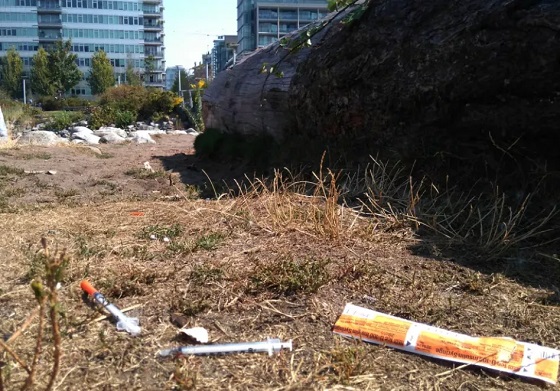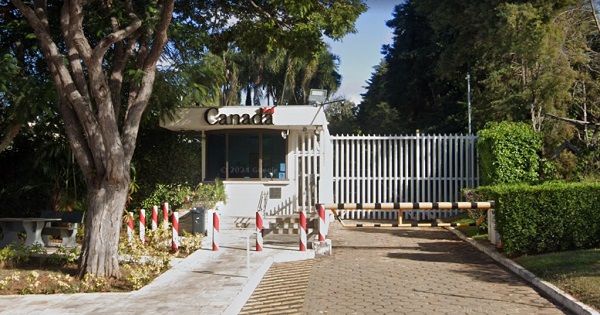Addictions
14-year old Kamilah Sword died after becoming addicted to diverted “safer supply” opioids. Now her loved ones are speaking up.


By Adam Zivo
New documentary exposes suffering caused by Canada’s “safer supply” programs
It has been widely reported that “safer supply” opioids are getting into the hands of youth and causing new addictions and deaths – but this fact, terrible as it is, can feel abstract to many. That’s why I’ve released this new 28-minute documentary, “Government Heroin 2: The Invisible Girls,” to illustrate the terrible harms being inflicted upon families by this failed policy.
The film focuses on the story of Kamilah Sword, a 14-year-old girl from Metro Vancouver who died of drug-related causes in 2022. Before her death, Kamilah and her friends had been using hydromorphone, an opioid as potent as heroin, that originated from government-funded safer supply programs.
These programs claim to reduce overdoses and deaths by providing addicts with pharmaceutical-grade addictive drugs – typically hydromorphone – as an alternative to riskier street substances. In reality, though, most addicts simply divert (sell or trade) their safer supply to the black market to acquire stronger drugs, such as illicit fentanyl. This then floods surrounding communities with hydromorphone, crashing its street price by up to 95 per cent and fueling new addictions.
Kamilah and her friends were victims of this corrupt system.
In 2021, hydromorphone pills suddenly became popular at their school. The pills, which were colloquially called “dillies,” were abundant and cheap and many teenagers did not believe that they were dangerous to experiment with, as they had originally been prescribed by the government and were marketed as “safe.”
The girls did not understand that they were essentially playing with heroin. Not until it was too late. But they were hopelessly addicted by then and as their opioid tolerances grew, so did their appetite for dillies.
Two of Kamilah’s friends – Amelie North and Madison (a pseudonym) – escalated to using fentanyl and eventually went to rehab. But Kamilah herself was not so lucky. She was found dead, curled up in the fetal position in her bed and with foam on the corner of lips, one warm August morning.
It was only after her death that her father, Greg Sword, learned about how safer supply had destroyed the lives of his daughter and her friends. Amelie and Madison explained to him, for example, how they would sometimes travel downtown and purchase dillies directly from safer supply patients, who gave the cheapest prices.
The Trudeau Liberals and BC NDP have spent years aggressively advocating for safer supply and have repeatedly denied that diversion is a serious issue that harms youth. So when Kamilah’s loved ones went public with their story in the summer of 2023, it caused a national scandal.
The situation was further complicated when the BC Coroners Service, after a considerable delay, released Kamilah’s coroner’s report in late December 2023. The report ruled out hydromorphone as a cause of death and claimed that Kamilah had died of a cardiac arrhythmia (irregular heartbeat) caused by cocaine and MDMA.
But when several physicians and forensic pathologists reviewed the report, they noticed some concerning irregularities.
As Kamilah’s body was not sent to autopsy (a scandal in itself), it would’ve been impossible to confidently diagnose an arrhythmia as a cause of death. And in complex polydrug cases such as Kamilah’s, the best practice would have been to list every major death as contributing to mortality – including hydromorphone.
Additionally, the coroner claimed that it was unknown from where the hydromorphone in Kamilah’s body had originated – even though Kamilah’s friends and family had been clear, across several media reports, that the drugs were diverted safer supply. It was impossible that the BC Coroners Service would have been unaware of this, but, strangely enough, no attempt was made by the coroner to interview Kamilah’s loved ones about her death, despite such interviews being regular practice.
Subscribe for free to get BTN’s latest news and analysis, or donate to our journalism fund.
Greg Sword, along with Amelie and her mother, recently launched a class action lawsuit against a wide array of defendants – including the governments of British Columbia and Canada – for irresponsibly marketing and prescribing safer supply, and for their “wilful blindness” to the prevalence and dangers of diversion.
The tragedy of this story cannot be adequately captured with words. The tears of a mourning father need to be seen and heard to be grasped. The sobs of a mother who laments her daughter’s fentanyl addiction has no substitute.
This is why Government Heroin 2: The Invisible Girls exists. To give these families a chance to be properly understood. And to better inform the public, through visceral storytelling, of the outrageous failures of Canada’s institutions and addiction policies.
This film is the second in a series. The first installment – “Government Heroin” – focuses on a 25-year-old student in Ontario who purchased thousands of diverted safer supply films. That 19-minute film provides a slightly more technical overview of the safer supply diversion scandal, so while each film stands on its own, the two also pair together very well (with a brisk total runtime of only 47 minutes).
I implore you to watch this new documentary, and its predecessor, too, if possible. They are sad and challenging, and yet vitally necessary for anyone who is concerned about Canada’s eroding public order and, of course, the predations of organized crime.
Subscribe to Break The Needle. Our content is always free – but if you want to help us commission more high-quality journalism, consider getting a voluntary paid subscription.
Addictions
The War on Commonsense Nicotine Regulation

From the Brownstone Institute
Cigarettes kill nearly half a million Americans each year. Everyone knows it, including the Food and Drug Administration. Yet while the most lethal nicotine product remains on sale in every gas station, the FDA continues to block or delay far safer alternatives.
Nicotine pouches—small, smokeless packets tucked under the lip—deliver nicotine without burning tobacco. They eliminate the tar, carbon monoxide, and carcinogens that make cigarettes so deadly. The logic of harm reduction couldn’t be clearer: if smokers can get nicotine without smoke, millions of lives could be saved.
Sweden has already proven the point. Through widespread use of snus and nicotine pouches, the country has cut daily smoking to about 5 percent, the lowest rate in Europe. Lung-cancer deaths are less than half the continental average. This “Swedish Experience” shows that when adults are given safer options, they switch voluntarily—no prohibition required.
In the United States, however, the FDA’s tobacco division has turned this logic on its head. Since Congress gave it sweeping authority in 2009, the agency has demanded that every new product undergo a Premarket Tobacco Product Application, or PMTA, proving it is “appropriate for the protection of public health.” That sounds reasonable until you see how the process works.
Manufacturers must spend millions on speculative modeling about how their products might affect every segment of society—smokers, nonsmokers, youth, and future generations—before they can even reach the market. Unsurprisingly, almost all PMTAs have been denied or shelved. Reduced-risk products sit in limbo while Marlboros and Newports remain untouched.
Only this January did the agency relent slightly, authorizing 20 ZYN nicotine-pouch products made by Swedish Match, now owned by Philip Morris. The FDA admitted the obvious: “The data show that these specific products are appropriate for the protection of public health.” The toxic-chemical levels were far lower than in cigarettes, and adult smokers were more likely to switch than teens were to start.
The decision should have been a turning point. Instead, it exposed the double standard. Other pouch makers—especially smaller firms from Sweden and the US, such as NOAT—remain locked out of the legal market even when their products meet the same technical standards.
The FDA’s inaction has created a black market dominated by unregulated imports, many from China. According to my own research, roughly 85 percent of pouches now sold in convenience stores are technically illegal.
The agency claims that this heavy-handed approach protects kids. But youth pouch use in the US remains very low—about 1.5 percent of high-school students according to the latest National Youth Tobacco Survey—while nearly 30 million American adults still smoke. Denying safer products to millions of addicted adults because a tiny fraction of teens might experiment is the opposite of public-health logic.
There’s a better path. The FDA should base its decisions on science, not fear. If a product dramatically reduces exposure to harmful chemicals, meets strict packaging and marketing standards, and enforces Tobacco 21 age verification, it should be allowed on the market. Population-level effects can be monitored afterward through real-world data on switching and youth use. That’s how drug and vaccine regulation already works.
Sweden’s evidence shows the results of a pragmatic approach: a near-smoke-free society achieved through consumer choice, not coercion. The FDA’s own approval of ZYN proves that such products can meet its legal standard for protecting public health. The next step is consistency—apply the same rules to everyone.
Combustion, not nicotine, is the killer. Until the FDA acts on that simple truth, it will keep protecting the cigarette industry it was supposed to regulate.
Addictions
The Shaky Science Behind Harm Reduction and Pediatric Gender Medicine


By Adam Zivo
Both are shaped by radical LGBTQ activism and questionable evidence.
Over the past decade, North America embraced two disastrous public health movements: pediatric gender medicine and “harm reduction” for drug use. Though seemingly unrelated, these movements are actually ideological siblings. Both were profoundly shaped by extremist LGBTQ activism, and both have produced grievous harms by prioritizing ideology over high-quality scientific evidence.
While harm reductionists are known today for championing interventions that supposedly minimize the negative effects of drug consumption, their movement has always been connected to radical “queer” activism. This alliance began during the 1980s AIDS crisis, when some LGBTQ activists, hoping to reduce HIV infections, partnered with addicts and drug-reform advocates to run underground needle exchanges.
The Bureau is a reader-supported publication.
To receive new posts and support my work, consider becoming a free or paid subscriber.
In the early 2000s, after the North American AIDS epidemic was brought under control, many HIV organizations maintained their relevance (and funding) by pivoting to addiction issues. Despite having no background in addiction medicine, their experience with drug users in the context of infectious diseases helped them position themselves as domain experts.
These organizations tended to conceptualize addiction as an incurable infection—akin to AIDS or Hepatitis C—and as a permanent disability. They were heavily staffed by progressives who, influenced by radical theory, saw addicts as a persecuted minority group. According to them, drug use itself was not the real problem—only society’s “moralizing” norms.
These factors drove many HIV organizations to lobby aggressively for harm reduction at the expense of recovery-oriented care. Their efforts proved highly successful in Canada, where I am based, as HIV researchers were a driving force behind the implementation of supervised consumption sites and “safer supply” (free, government-supplied recreational drugs for addicts).
From the 2010s onward, the association between harm reductionism and queer radicalism only strengthened, thanks to the popularization of “intersectional” social justice activism that emphasized overlapping forms of societal oppression. Progressive advocates demanded that “marginalized” groups, including drug addicts and the LGBTQ community, show enthusiastic solidarity with one another.
These two activist camps sometimes worked on the same issues. For example, the gay community is struggling with a silent epidemic of “chemsex” (a dangerous combination of drugs and anonymous sex), which harm reductionists and queer theorists collaboratively whitewash as a “life-affirming cultural practice” that fosters “belonging.”
For the most part, though, the alliance has been characterized by shared tones and tactics—and bad epistemology. Both groups deploy politicized, low-quality research produced by ideologically driven activist-researchers. The “evidence-base” for pediatric gender medicine, for example, consists of a large number of methodologically weak studies. These often use small, non-representative samples to justify specious claims about positive outcomes. Similarly, harm reduction researchers regularly conduct semi-structured interviews with small groups of drug users. Ignoring obvious limitations, they treat this testimony as objective evidence that pro-drug policies work or are desirable.
Gender clinicians and harm reductionists are also averse to politically inconvenient data. Gender clinicians have failed to track long-term patient outcomes for medically transitioned children. In some cases, they have shunned detransitioners and excluded them from their research. Harm reductionists have conspicuously ignored the input of former addicts, who generally oppose laissez-faire drug policies, and of non-addict community members who live near harm-reduction sites.
Both fields have inflated the benefits of their interventions while concealing grievous harms. Many vulnerable children, whose gender dysphoria otherwise might have resolved naturally, were chemically castrated and given unnecessary surgeries. In parallel, supervised consumption sites and “safer supply” entrenched addiction, normalized public drug use, flooded communities with opioids, and worsened public disorder—all without saving lives.
In both domains, some experts warned about poor research practices and unmeasured harms but were silenced by activists and ideologically captured institutions. In 2015, one of Canada’s leading sexologists, Kenneth Zucker, was fired from the gender clinic he had led for decades because he opposed automatically affirming young trans-identifying patients. Analogously, dozens of Canadian health-care professionals have told me that they feared publicly criticizing aspects of the harm-reduction movement. They thought doing so could invite activist harassment while jeopardizing their jobs and grants.
By bullying critics into silence, radical activists manufactured false consensus around their projects. The harm reductionists insist, against the evidence, that safer supply saves lives. Their idea of “evidence-based policymaking” amounts to giving addicts whatever they ask for. “The science is settled!” shout the supporters of pediatric gender medicine, though several systematic reviews proved it was not.
Both movements have faced a backlash in recent years. Jurisdictions throughout the world are, thankfully, curtailing irreversible medical procedures for gender-confused youth and shifting toward a psychotherapy-based “wait and see” approach. Drug decriminalization and safer supply are mostly dead in North America and have been increasingly disavowed by once-supportive political leaders.
Harm reductionists and queer activists are trying to salvage their broken experiments, occasionally by drawing explicit parallels between their twin movements. A 2025 paper published in the International Journal of Drug Policy, for example, asserts that “efforts to control, repress, and punish drug use and queer and trans existence are rising as right-wing extremism becomes increasingly mainstream.” As such, there is an urgent need to “cultivate shared solidarity and action . . . whether by attending protests, contacting elected officials, or vocally defending these groups in hostile spaces.”
How should critics respond? They should agree with their opponents that these two radical movements are linked—and emphasize that this is, in fact, a bad thing. Large swathes of the public understand that chemically and surgically altering vulnerable children is harmful, and that addicts shouldn’t be allowed to commandeer public spaces. Helping more people grasp why these phenomena arose concurrently could help consolidate public support for reform and facilitate a return to more restrained policies.
Adam Zivo is director of the Canadian Centre for Responsible Drug Policy.
For the full experience, please upgrade your subscription and support a public interest startup.
We break international stories and this requires elite expertise, time and legal costs.
-

 International2 days ago
International2 days agoBiden’s Autopen Orders declared “null and void”
-

 MAiD2 days ago
MAiD2 days agoStudy promotes liver transplants from Canadian euthanasia victims
-

 Business2 days ago
Business2 days agoCanada has given $109 million to Communist China for ‘sustainable development’ since 2015
-

 Crime1 day ago
Crime1 day agoPublic Execution of Anti-Cartel Mayor in Michoacán Prompts U.S. Offer to Intervene Against Cartels
-

 Business2 days ago
Business2 days agoYou Won’t Believe What Canada’s Embassy in Brazil Has Been Up To
-

 Environment2 days ago
Environment2 days agoThe era of Climate Change Alarmism is over
-

 Automotive2 days ago
Automotive2 days agoCarney’s Budget Risks Another Costly EV Bet
-

 Censorship Industrial Complex2 days ago
Censorship Industrial Complex2 days agoSenate Grills Meta and Google Over Biden Administration’s Role in COVID-Era Content Censorship









